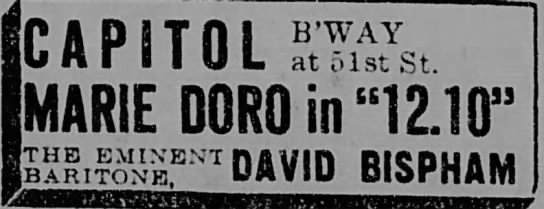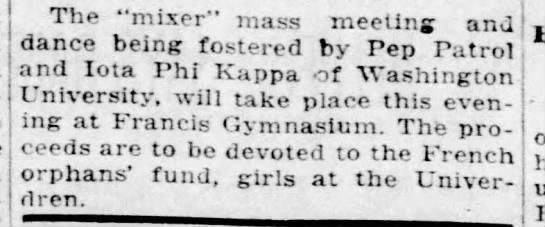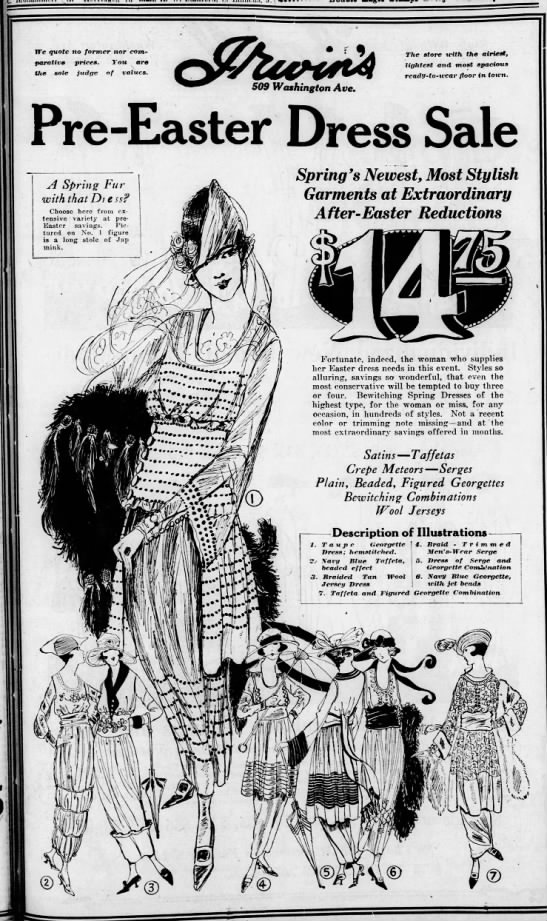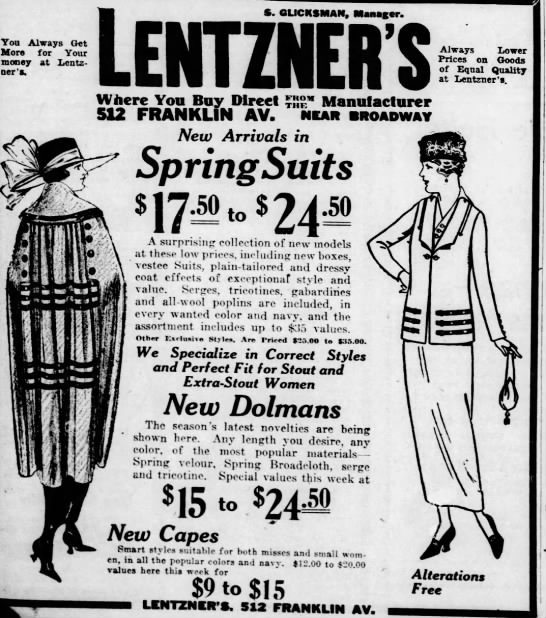Here is the final installment of Helen's diary and the story of what happened to Helen after 1919.
If Helen had not signed off with her name I would never have known who wrote the diary or learned so much about her life and times and family.
December
Monday 22
Stayed home to rest all day. I certainly needed it. Ruth had some people over in the evening. We had a good time together. Herbert – Ruth – Frances – Arthur & I. We went to bed about 1 a.m.
Tuesday 23
Went out with Mrs. Sessel – to dinner at Garibaldi’s – then we went to matinees at the Rialto – a beautiful house – lighted done 8 – a wonderful symphony orchestra. Evening – Youngs & Rossbach.
Wednesday 24
Out again with Mrs. Sessel to Equarium– Wall Street – Woolworth Bldg to Trinity Cemetery. Home to her shop. A Xmas party & lots of fun. To Moulin Rouge with R.H.A. Edith Cohen & myself. It was wonderful. Broadway is too fascinating for words. This was the day that grandpa died, but I didn’t know of it until I returned. We all felt terrible to lose him. May his soul rest in peace.
Thursday 25
Xmas day. Fooled around with the boys at home. Ruth did some general household tasks. We had lunch and went out for a long walk. Saw the city college. Grant’s tomb, Columbia and a variety of other things. Walked home along Riverside. Kings came over.
Friday 26
Spent the day with Minnie Young – went over to Newark – home to dinner with Mr. Butbaum & Arthur as guests. Pawlingers came over in evening. We had a nice time, but I didn’t feel very well. Slept overnight with Youngs.
Saturday 27
Visited Lord & Taylors – Altmans – Macy’s – etc. Went to the Capitol matinee in the afternoon. They have a beautiful promenade. Went to Tiffins for lunch. Home & to Rusenweber’s with Rossback, Ruth & co. It was wild.
Sunday 28
Fooled around. Out with Jul in afternoon – then to Brooklyn with Lenore Rosenson. Dinner & reception for Junior Aux. of Council of Jewish Women to which I was a delegate. Alvin & Lenore are dears. [illegible] & mother & daddy too. Very fine & wealthy people.
Monday 29
Convention meeting. There was a lovely crowd there. Luncheon at Unity Club – meeting. Found dance at Elks Club in the evening. I was with Lenore’s uncle. Alvin & he & Lenore were darling to me, I had such a wonderful time. Pop, Herb & Arthur came over to see me.
Tuesday 30
Convention has been very interesting. Luncheon & last meeting. Home to N.Y. Saw “Monsieur Beaucaire” with Herb & Ruth & Pop. It was very good lyric opera. Lunch at Gertners. Very nice place – Saw Times newspaper being printed.
Wednesday 31
Climbed statue of Liberty with cousin Minnie. Heard ‘Forza del Destino’ with Caruso & Ponselle as leads in evening. It was wonderful. Spent remainder of week seeing & visiting museums, bought a hat – pop gave me a seal coatie – went to Sorbers & Roof Garden, visited all hotels – had lunch in some exclusive places – in short, had a glorious old time. This certainly has been a most exciting and pleasant year for me. If grandpa had only lived it would have been perfect. Wishing myself & all those I love happiness –
Helen Korngold
*****
Notes:
Dec 22
Herbert, Ruth, Frances, Arthur Pawliger of 1915 Broadway. Herbert Lincoln Pawligerwas a commercial salesman who had visited with the Korngold family when in St. Louis.
December 23
Mrs. Sessel may be Nathalia Sessel, married to Samuel Sessel who had a millinery shop and was born in St. Louis. The 1920 census shows Sam and Nathalia (1886-1951) had a daughter, Fern.
 |
| the Rialto |
The Rialto was the 'Temple of the Motion Picture, in 1916 on Broadway near 42nd St. in Manhatten. It seated almost 2,000 and had a fine orchestra. The photo-play was Red Hot Dollars starring Charles Ray. “As a laborer, and later as the adopted son of a wealthy man, as a rough youngster being polished down for society, and as the suitor for the hand of a workingman’s daughter, Ray has the part varied enough to please all his admirers.” From The Brooklyn Daily Eagle, Dec 28, 1919.
Ray was one of the biggest box-office stars of his time. For a biography of Ray: http://www.goldensilents.com/stars/charlesray.html or http://torontofilmsociety.com/film-notes/the-coward-1915/
 |
| Charles Ray |
A Fox movies Sunshine Comedy called Chicken A La Cabaret was ‘the chaser.’ The Sun of December 28, 1919, reported, "Also showing was ‘a kindergarten’ of wild Alaskan bear cubs, Bizet’s Pearl Fisher sung by tenor Sudwarth Frazier and baritone Edward Albano, and ‘ecstasies by the orchestra over List’s First Rhapsody ‘will fill the chinks in the program."
December 24
The Moulin Rouge Cafe at Broadway and 48th St. offered dance reviews of all sorts, and the Moulin Rouge Orchestra under the direction of Ben Selvin offered ‘dance music and impromptu entertainment’ according to The New York Herald of December 7, 1919.
 |
| The New York City Aquarium |
Equarium or New York Aquarium opened in December 1896 at Castle Garden at the Battery in Manhattan. In 1919 it attracted 5,000 attendees daily.
http://placesnomore.wordpress.com/tag/new-york-aquarium/
 |
| The Woolworth Building in 1919 |
The Woolworth Building at 233 Broadway in Manhattan was completed in 1913 and is one of the oldest skyscrapers in the world. http://www.nyc-architecture.com/SCC/SCC019.htm
 |
| Trinity Church |
Trinity Church Cemetery in Manhattan goes back to 1697 and is the resting place of personages such as John Jacob Astor, inventor Robert Fulton, General Horatio Gates of the Revolutionary War, and Alexander Hamilton. Its steeple was once where people went for the best overview of the city. Munsey's Magazine. November 1899. http://www.digitalhistoryproject.com/2012/06/hotels-of-new-york-waldorf-astoria-park.html
Helen's maternal grandfather David Joshua Frey died on Dec. 24, 1919, in a tragic accident.
David was born Oct. 18, 1840, in Rzeszów Galacia, Austria to Benjamin and Yittel Kressel Frey, and immigrated at age 24 to the United States. He married Sophia Herz, born in 1847 in Lörzweiler, Hessen, daughter of Abraham Mendle and Sarah Herz, and immigrated to the United States at age 20.


Dec 25
City College of New York in Manhattan was established in 1847.
Riverside Drive follows the Hudson River. Columbia University and Grant’s Tomb are on Riverside Drive.
Helen was touring all the must-see places of New York City.
Justus George Frederick wrote in his 1919 guide Adventuring in New York:
In our hurrying American way we do not often give time to the aesthetic outlook but who has not paused as he came upon Madison Square of a winter's evening at 5 or 6 o clock when a thousand points of light glimmer through the trees from a thousand towered windows in particular from the wafer-like Flatiron Building or the giant toy the Metropolitan Tower?
Who has not of a summer's balmy evening in Riverside Drive Park gazed out upon the broad bosom of the stately Hudson illumined with the binnacle lamps of battleships and yachts the stateroom lamps and searchlights of steamers the dim home beacons on the other shore of dwellings upon the Pallisades?
Who has not stood at the Battery and swung his eyes upon the ever-changing spectacle of the fairy port of the new World?
Who has not sniffed the October air from the top of a Fifth Avenue bus through the endless pomp and panoply of the most famous street in the world?
Who has been atop a great skyscraper by day or night and failed to fall into a gargantuan reverie?
It is a challenge to feeling and thought to gaze out from the windows of the Bankers Club in the Equitable Building from the Whitehall Club roof garden or from the topmost windows of any large building but especially from the stately vantage point of the Woolworth or Metropolitan Tower?
What human ant though he be cannot add a cubit to his stature from his feelings at such an adventure?
Dec 26
Later in the diary, Helen refers to "cousin Minnie." Helen's father's mother was Joacha Young and Minnie may be related to that family. I do find a Minnie Young married to Max Young who was a tailor born in Russia and by 1915 had his own clothing /dry goods store. The census shows they had children Louis, Nathan, and Helen.
I find several marriage licenses in New York City for Butbaums and also a WWI Draft Card for David Butbaum, born Sept. 15, 1894, in Austria. He was an operator for Greenfield and was of medium height and weight with brown eyes and hair.
December 27
Helen visited the premier New York department stores, including Lord & Taylors, Altmans, and Macy’s.
John Rusenweber appears on the 1880 New York City Census as a liquor dealer from Bavaria. He and his wife Fredericka were 28, and their children included Emma, age 7, Barbara, age 5, and Lizzie aged 2. They lived on 8th Avenue.
The Capitol Matinee was on Broadway at 51st St. and was advertised as ‘The World’s Largest Theater.’ Matinee seats cost 30 cents to a dollar.

According to The New York Sun of December 27, Marie Doron in 12.10 was playing, with ‘Eminent Baritone David Bispham’ also performing. Bispham was a Philadelphia Quaker who studied opera and had sung at the Royal Opera and the Met. You can hear him sing on Youtube.
 |
| David Bispham |
The newly formed Capitol Symphony Orchestra was to play Tchaikovsky’s Capriccio Italien and an ‘elaborate score’ to go with the featured motion picture. An article on Bispham (1857 – 1921), America’s first internationally known opera singer, is found at http://en.wikipedia.org/wiki/David_Bispham

December 28
Jul was first mentioned in the diary on January 2! He was one of the soldiers at the barracks who Helen met and corresponded with; he sent her a pillow top from Asheville, NC. Jules Koloditsky was a salesman living in the Brox.
Lenore and Alvin Rosenson appear with parents Hyman B. and Mame on the January 1915 New York State Census. Lenore was aged 19 and Alvin was 16 years old. They lived on Rodney in Brooklyn. Hyman was from Prussia and worked as a liquor wholesaler. The 1910 census shows Hyman immigrated in 1883. Also on that census appear his son Theodore, age 19, his brother Isaac and sister Belle, and a servant.

The Junior Council of Jewish Women article in The Brooklyn Daily, Dec. 29, 1919.
December 29
Unity Club is the name of an organization out of the Unitarian church.
Leonore’s uncle Isaac Rosenson
December 30
Gertner’s was at 1446 Broadway and advertised “a la carte all hours.”

Andre Messager’s lyric opera “Monsieur Beaucaire” is based on a book by Booth Tarkington. The opera was first performed on April 7, 1919, in London and later opened on Broadway. An advertisement in The Sun of December 31 shows it was playing at the New Amsterdam Matinee at $2.00 for the ‘best seats.’
December 31
Seal Coatie- a short coat of seal fur. Perhaps her father bought it at the August fur sales
‘La Forza del Destino’ by Verdi was performed by Enrico Caruso and Rosa Ponselle. A synopsis can be found at http://www.metoperafamily.org/metopera/history/stories/synopsis.aspx?customid=126
The Waldorf Astoria would have been the original Waldorf hotel on 5th Avenue and 33rd, built in 1893 by William Waldorf Astor. In 1897 it was joined to the adjacent Astor hotel, built by John Jacob Astor. The Waldorf=Astoria was rebuilt on Park Avenue in the 1920s, and the Empire State Building was built on the site. http://www.newyork.com/articles/hotels/secrets-of-the-waldorf-astoria-hotel-63985/
Roof Gardens were hugely popular and most of the premier hotels offered them. Justus George Frederick in Adventuring in New York offered a list:
One of the special delights of New York because of its high buildings is the increasing vogue of the Roof Garden, so cool and remote from the fetid pavement in Summer. Most of the large hotels open their roof gardens early in June a few by the end of May and here one can dine and dance comfortably in the open as far from the bustle and heat of the city as if a hundred miles lay between. Here are a few of the popular or newest hotels also some specialized hotels and apartment hotels.
Astor 44th St & Broadway also Roof Garden
Biltmore 43rd St & Madison Ave also Roof Garden
Majestic 72nd St and Central Park West also Roof Garden McAlpin 33rd St & Broadway also Roof Garden
Pennsylvania 33rd & 7th Ave also Roof Garden
Ritz Carlton 46th St & Madison Ave also Roof Garden
Waldorf 33rd St & Fifth Ave also Roof Garden
Plaza 59th St & Fifth Ave also Roof Garden
Commodore 42nd St & Lexington Ave also Roof Garden
*****
Helen's Later Life:
Helen had a career as a teacher at Normandy High School in St. Louis, her
photo appearing in the 1924, 1933, 1934, 1935, 1936, and 1937 yearbooks.
 |
| 1932 newspaper notice |
 |
| 1936 Normandy HS yearbook |
 |
| 1937 Normandy HS yearbook |
Her degrees included A.B. Washington University, M.A. Columbia University, and the University of Southern California. She worked in Commercial Subjects in the Guidance Department.
 |
| 1936 newspaper article |
In 1936 Helen appears on the census as a teacher at Normandy High School in St. Louis.
She wrote an article, Guidance in Action: A High School Program in St. Louis, which appeared in “The Vocational Guidance Journal."
 |
| 1922 newspaper notice that Helen and her sister Otilia vacationed in Michigan |
Helen made at least one trip abroad. A September 3, 1926, Passenger List shows that Helen and her younger sister Otilia, age 22, arrived in New York City on the SS Rotterdam out of Southampton, England. Their address was 5253 Waterman, St Louis, MO. The St Louis City Directory of 1932 shows Helen and Otila were both teachers, living with Jacob and Eva at 5253 Waterman St.
| Fritz Herzog |
Helen married Fritz Herzog. The wedding announcement read,
Mr. and Mrs. J. B. Korngold, 5253 Waterman Boulevard, have announced the marriage of their daughter. Miss Helen, and Fritz Herzog. which took place Tuesday, Sept. 21. The bride received her M. A. degree from Washington University, University, and now is employed as head of the commercial department and director of vocational guidance at the Normandy High School. Mr. Herzog received his Ph. D. degree from Columbia University, New York, and at present is a member of the staff of Cornell University.
Fritz Herzog was born December 6, 1902, in Poland and died November 21, 2001, in East Lansing, Michigan.
Fritz was an American mathematician known for his work in complex analysis and power series. He studied at the University of Berlin from 1928 to 1933. Anti-Semitism under Hitler forced him to emigrate. On July 27, 1933, he arrived at New York City on the S.S. Washington out of Berlin. The Passenger List states that he was 30, a student from Poznan, Poland and was Hebrew.
Fritz received his Ph.D. degree at Columbia University with a thesis entitled Systems of Algebraic Mixed Difference Equations advised by Joseph Ritt (1934).
He worked for the Smelting & Refining Company for two years as a statistician.
From 1938 to 1943 Herzog was an electrical engineering research associate at Cornell University working with Michel G. Malti on dynamo research. Together they solved an important electric power problem on balancing dynamos, which had remained open since the days of Michael Faraday a century before.
The 1939 Ithaca, NY City Directory shows Helen as Mrs. Fritz Herzog, working at Cornell University as a “research elec. Assn.”
The April 1940 Ithaca, NY City Directory shows Helen married to Fritz Herzog. Helen was 42 years old. The 1940 U.S. Census for Ithaca, NY shows Friz was a college professor with a four-year college degree, living in rented housing, and married to Helen Sarah Herzog. Fritz earned $1650 a year and had worked 11 hours the previous week. Helen worked as a clerk at the university earning a salary of $0 a year and had worked 63 hours the previous week.
In 1941 and 1942 Helen appears in the Ithaca, New York city directory as a clerk.
The mystery of how Helen's diary showed up in a Lansing, Michigan resale shop was made clean when I learned that Fritz spent the remainder of his career teaching at Michigan State University in East Lansing, MI. He was a visiting professor in 1943 and an associate professor in 1946. Along with Michel G. Malti, he solved an important problem in dynamo research.
A footnote in the May 1971 Vol. 78, No. 5 The American Mathematical Monthly states, “Fritz Herzog received his Columbia University PhD. under J.F. Ritt. His first position was at Cornell, and he has been at Michigan State since 1943, except for visits to Washington University and the University of Michigan. He is a recipient of a Michigan State Distinguished Faculty award. His principal research interests are complex function theory and power series.”
This gave me a clue as to how Helen and Fritz met! It had to be while Fritz was teaching at Washington University in St. Louis--Helen's Alma Mater.
Fritz was also known for his involvement in undergraduate education. The Michigan State University’s Fritz Herzog Prize Endowment Fund competition honors Fritz, who “devoted significant efforts at undergraduate education and helped successfully prepare students of the Putnam exam” according to a June, 2010 MSU press release.
Fritz and Helen appear in the 1945 East Lansing, MI City Directory. The 1984 Directory show they lived at 1532 Cahill Dr, East Lansing.
In 1956 and 1959 Helen appears in the East Lansing city directory working as a clerk at Michigan State University and Fritz as a professor at MSU.
Fritz was a member of the American Mathematical Society and published Some Properties of the Fejer Polynomials, by Fritz Herzog and George Piranian, in 1955.
In 1969 Fritz was awarded the Past Distinguished Faculty award in Natural Science. A footnote in the May 1971 Vol. 78, No. 5 The American Mathematical Monthly states, “Fritz Herzog received his Columbia University PhD. under J.F. Ritt. His first position was at Cornell, and he has been at Michigan State since 1943, except for visits to Washington University and the University of Michigan. He is a recipient of a Michigan State Distinguished Faculty award. His principal research interests are complex function theory and power series.”
In his autobiography, Enigmas of Chance, Mark Kac wrote, "At Cornell, only a fellow instructor, Fritz Herzog, was not a native American. He was a refugee from Germany who tried to speed up his process of Americanization by reading the comics. He gave up the struggle when he first came across Popeye the Sailor's "I yam what I yam" and discovered that a yam was a sweet potato."
Rings And Things And A Fine Array Of Twentieth Century Associative Algebra by Carl Clifton Faith quotes Fritz Herzog saying, "Teaching is a calculus thing--you have to minimize."
Helen passed on July 25, 1988. Fritz died of prostate cancer on November 21, 2001. Helen’s diary from 1919 ended up in a South Lansing, MI flea market shop where I discovered it.
In 2018 I received a surprise phone call from a woman who began, "I believe you have my aunt's diary." Chills ran up my spine! I finally had contact with someone from Helen's family!
Helen's sister Lorine Esther Korngold married Harry Mendleson. His son David Frey Mendleson married Mary Ann and their daughter was Lorine, my contact.
Fritz Herzog's brother Paul Herzog wrote a book about their family history, Three Generations: The Dispersion of a German Jewish Family. Lorine told shared the genealogy pages with Stars of David marking those family members lost in the Holocaust.
Lorine sent me copies of the Herzog genealogy, marked with stars for the people who perished in the Holocaust.
Helen and Fritz were disappointed when they had no children but loved Helen's nieces and nephews. I was told that they were well-beloved visitors.
 |
| Helen bathing Lorine at Helen's home in Michigan, 1957 |
 |
| Helen, Fritz and baby Lorine, 1957 |
 |
| Lorine and her Aunt Florence, Helen's youngest sister |
 |
| Lorine Korngold Mendleson, Helen's sister, is on the left |
Later I also heard from Anne Nathan, whose grandfather was Karol Korngold, Helen's brother, and from John Reichman, Florence Korngold's son.
 |
I had sent Helen's diary to Lorine who shared it with her mother and cousins.
I hope you enjoyed meeting Helen Korngold and a glimpse into St. Louis in 1919.






















